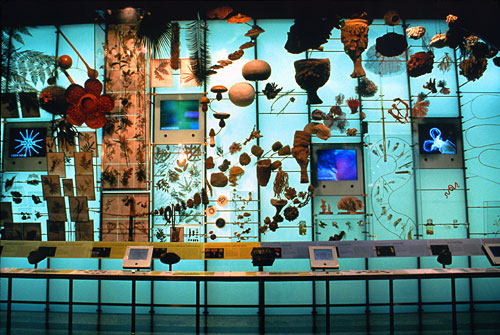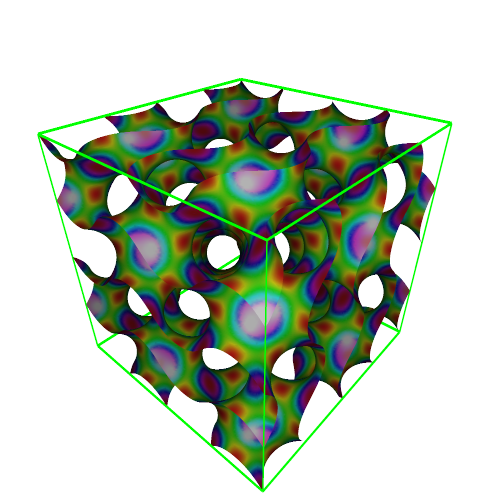Butterfly Wings, Colors, and Solar Cells
Images courtesy amnh.org and vipnyc.org
Pinned up along one side of the wall was a row of brilliantly colored butterflies. They were so glittery and shiny and their patterns so vivid in color that I wanted to sew a coat out of their wings and wear it for the rest of my life. But I abandoned the idea, reasoning that the colors would probably fade with time and also because a coat made of insect parts is gross.
Fast forward to today and the butterfly wing coat idea is still gross. However, I did find out that the colors on butterfly wings don’t fade because … wait for it … they are made of crystal nanostructures called gyroids. “These are ‘mind-bendingly weird’ three-dimensional curving structures that selectively scatter light,” according to Richard Prum, chair and the William Robertson Coe Professor in the Department of Ornithology, Ecology and Evolutionary Biology at Yale (Source: Physorg.com). Geometrically speaking, a gyroid is “an infinitely connected triply periodic minimal surfacediscovered by Alan Schoen in 1970″ (Wikipedia) and it’s highly awesome. You can think of it as a network of “three bladed boomerangs” if that helps (Physorg.com).
Image courtesy Wikipedia
The gyroids on butterfly wings are made of chitin, which is a tough starchy material that forms the exterior of insects and crustaceans. The chitin that makes up the exoskeletons of crabs and scorpions is typically deposited on the outer membranes of cells, and it doesn’t usually take the form of a gyroid.
The Yale research team used an X-ray scattering technique at the Argonne National Laboratory in Illinois to determine that, “essentially, the outer membranes of the butterfly wing scale cells grow and fold into the interior of the cells. The membranes then form a double gyroid — or two, mirror-image networks shaped by the outer and inner cell membranes. The latter are easier to grow but are not as good at scattering light. Chitin is then deposited in the outer gyroid to create a single solid crystal. The cell then dies, leaving behind the crystal nanostructures on the butterfly wing” (Physorg.com).
Okay, so the crystal nanostructures come in pretty colors and they’re durable. But the most exciting aspect of this line of research has to do with solar cells. Gyroid shapes can improve the efficiency of solar cells and other optical devices.
Image Credit: Michael Apel, Wikipedia Commons
Researcher Di Zhang and colleagues are turning to the microscopic solar scales on butterfly wings in their search for materials that may improve the already high efficiency of light-harvesting in dye-sensitized solar cells, also known as Grätzel cells after inventor Michael Grätzel. These solar cells can convert 10% of the light energy that strikes them into electricity (Source: ACS).
Di Zhang and co. used natural butterfly wings as a mold or template to make copies of the solar collectors, and transferred those light-harvesting structures to Grätzel cells. “Laboratory tests showed that the butterfly wing solar collector absorbed light more efficiently than conventional dye-sensitized cells. The fabrication process is simpler and faster than other methods, and could be used to manufacture other commercially valuable devices, the researchers say” (ACS). The more efficient our solar cells become, the fewer of them we’ll need to manufacture – meaning less waste, less space, less time, and more betterness.
WU XING:
I’m always distracted by things that are shiny. I’m placing this post in the fire category.
Cited:
“Novel Photoanode Structure Templated from Butterfly Wing Scales”, Chemistry of Materials. Provided by ACS via Physorg.com. Accessed 06/15/10. URL.
“Colors of Butterfly Wing Yield Clues to Light-Altering Structures” Provided by Yale University via Physorg.com. Accessed 06/15/10. URL.



















Butterfly wings do fade in sunlight. Leave a one of those magnificent blues in bright sunlight for a year and it will become a pale creamy imitation of itself. Not sure why -if it’s the structure which gives the color. Maybe the heat/ UV affects the starch in the gyroid structure and shrinks/warps it? Must take a look under the microscope someday…
[…] The researchers “assembled the nanofibers into repeating structures called photonic crystals that reflect specific wavelengths, or colors, of light. The wing scales of the Morpho butterfly, which give the insect its brilliant iridescent coloration, are natural examples of this kind of structure. The sensors are an iridescent color too, rather than black like ordinary carbon. That color changes when the fibers absorb toxins – a visible indication of their capacity for absorbing additional chemicals” (Brown). You can learn more about the nanoscale structures that make up butterfly wings here. […]
[…] a well-mannered material that manages to create a striking effect with a minimum of fuss. Taking a cue from butterfly wings, the colors in the film are created NOT through the use of pigments but rather through a series of […]
Leave a Wordpress Comment:
Ads
Watch ARCHITERIALS Videos on vimeo
Like on Facebook
Twitter
Flickr
Hit Counter
Ads
Blogs
Green
Journals/Publications
Materials
Network/News
Offices/People
Resources
Science
Pages
Archive
RSS and Email Subscriptions
Tag Cloud
3D 3D printer AB FAB academic acid acrylic actuated matter adaptive adhesive adsorption aerogel air air conditioning alloy aluminum amnh antibacterial antifungal ants april fool's architecture architecture robot artificial skin autonomous aviation awesome bacteria bamboo bananas beer bench bend bending biennale biocomputing biodegradable biodegradeable biomaterials biomimetics biomimicry biominerals biopolymer birds blast blast-resistant block blocks blogs Bloom Box brazil brick bubbles bucky bulk metallic glass butterfly calera canvas carbon carbon fiber carbon nanotubes carpet cars ceiling cellulose cement ceramic chain link chair charcoal charlie sheen chemicals chiller clay cloth cloud cmu coils color color-changing communication compound computer concrete condensation conducting conductive context cool coral cracks crystal cyborg demakersvan design digifab dirt disaster dna dror drywall dutch dynamic EAP earth ecocradle ecolect e coli ecology ecoresin ecovative elastic electric electricity electrochromic electroluminescent electronic energy energy recovery environment evaporative cooling experiment fabric fabrication facade fiber fiberglass fiber optic fiber optics fibers film FIRE flexible flickr fly ash foam fungus furniture garbage gel geodesic dome geometry gfrp gilgamesh glass glass fiber glow glue gold graphene green greensulate gsapp gypsum hard heat heavy heidi klum helix hemp hexagon hidden high performance hive honeybee humidity ice India ink insulation interference Internet inventables invisible invisible ink jello jellyfish just add water kevlar kinetic korea lace lamboo laser lattice leaves LED leed LEGO light light emitting light transmitting liquid lo mein london Loop.pH machines magic magnetic marine material materials meatball melting memory metabolic engineering METAL metal panel metamaterial micro microsensor microtools military milk MIT moisture multi-layer mushrooms mycelium nano nanogel nanotech nanotubes NASA new noise non-metallic oil OLED OMA ostrich oysters packaging paint panel panels paper paperfoam paraffin wax particles particulates petroleum phase change phosphorescent pink PLA plastic platinum pm-10 poetry pollution polymer polymers porcelain power precast printed printing protein public quadror radiant rain rammed earth reclaimed recycled reflective refracting Rem Koolhaas resin robot robotics roof rubber rugged sand sealant sealer search segmented self-healing sensor shape memory silica silicon silk skin skittles slats smog soft solar solar cell solar cells solar paint solid solid state lighting sound spider spider glue spray stabilized sand stone stretch stretchable strong structural structure studio dror sun sunglasses super supercritical sustainable switzerland tags tape technology TED tensile TEXAS textile textiles texture thermal thermochromatic thin thin film thread tiger stone tile tiles timber tio2 tires toaster tokujin yoshioka touch touch-sensitive toxic transparent t shirts tulip ultra-thin university of akron university of connecticut upcycling virus voc wall wallpaper WATER web wet whale wires WOOD woodwool wool workshop
WP Cumulus Flash tag cloud by Roy Tanck and Luke Morton requires Flash Player 9 or better.
Recent Comments
Ads
Recent Posts
Most Commented
Most Viewed